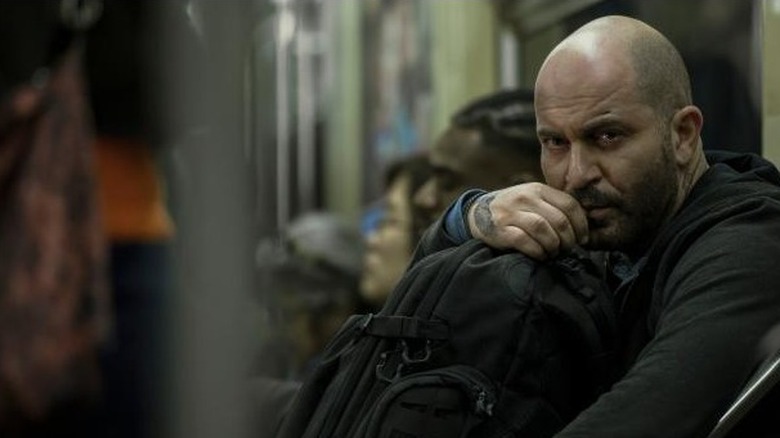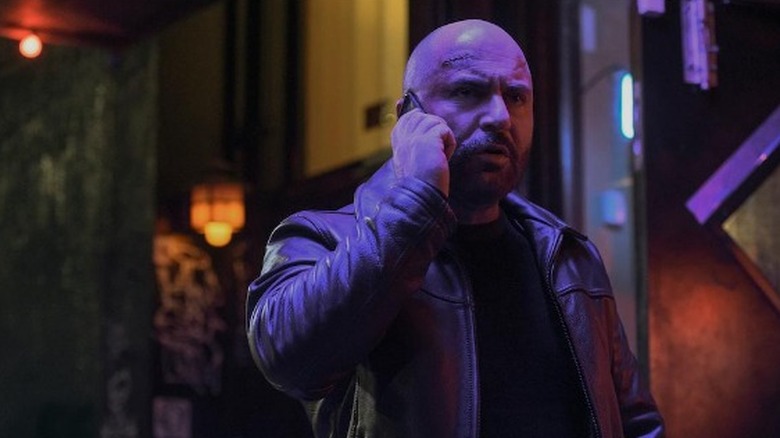The Ending Of Hit & Run Explained
This article contains spoilers for "Hit & Run."
The Netflix series "Hit & Run"— which reunited "Fauda" fans with the hit Israeli show's star and co-creator, Lior Raz — premiered on August 6th, and brought with it more twists, bends, and turns than a crazy straw. The basic premise of "Hit & Run" goes a little something like this: boy meets and marries girl, girl later gets hit and killed by a car while crossing the street, the perpetrators of said hit take off (hence the title), and grief-stricken boy then throws himself into a labyrinthian maze of violence, clues, and revelations on a quest to understand the motivation behind girl's death. Except, like everything else in directors Mike Barker and Neasa Hardiman's thriller, it's not quite that simple.
Fairly early on in the season, we learn that the proverbial Dead Girl (Kaelen Ohm) who acts as a catalyst for the series' narrative isn't quite who she claims to be. Known to her Israeli "tour guide" husband Segev (Raz) as the American dancer Danielle Wexler, the hit-and-run victim of the show's title is actually a CIA operative named Sophie. While living in Tel Aviv with her new husband and stepdaughter, Sophie was (apparently) dividing her time between being a professional dancer and spying on her lover Assaf (Lior Ashkenazi) — the Special Intelligence Liaison to Head of Israeli National Security.
A (very) brief "Hit & Run" recap
Ultimately, we find out that in the process of uncovering a big, juicy secret about Mossad (the Israeli national intelligence agency) Sophie killed an Israeli operative to avoid being caught, then jotted her discoveries down in code in a journal. Following this, her CIA mentor-handler in New York — "Martin Wexler" (Gregg Henry, of James Gunn's "Slither"), whom Segev thinks is his father-in-law — orders her to return to the U.S. immediately. Sadly, her hesitance to leave her unwitting-but-beloved husband and step-daughter behind causes her to take a day too long to leave Tel Aviv. On her way to the airport, she's mowed down while crossing the street.
In the aftermath of her murder, Segev enlists the help of his cousin — an Israeli detective named Tali (Moran Rosenblatt) — to help unravel the mystery of her death, which ultimately entangles him in the extraordinarily convoluted mystery of her life. Luckily, Segev has a special secret skill set of his own, courtesy of the training he received at his (also secret) former job as a black ops member of the Israeli Defense Forces. Assisting him on his journey around New York to bring his wife's killers to justice are former fellow Israeli mercenary Ron (Gal Toren), and his ex-lover (or very good friend), tenacious investigative journalist Naomi Hicks (Sanaa Lathan).
Naomi Hicks gives audiences subtext, but few answers
Hicks is essential to the impact and success of "Hit & Run," if only for her ability to act as a proxy for the audience. If the audience is asking themselves a question at any given point throughout the season, it's almost guaranteed to come out in her dialogue — a trait that's never more apparent than in the finale. "We've got the who," she says to Segev, regarding his wife's murder, and "we've got the what, but we really don't have the why." By the end of episode 9, "Search and Destroy," we still don't really have the why, though Hicks is treated to a variety of versions of it when she's kidnapped and held by Mossad boss, Tamir (Igal Naor). Hicks, who is now in possession of the coded journal, learns that the secret Sophie uncovered was a Mossad mission to spy on The White House. Spying's not a good look, she tells Tamir, for a nation that claims to be the United States' "best friend."
It's in this exchange with Tamir that the audience begins to understand just how many layers there are to this onion of a conflict: "What do you think the CIA has been doing in Israel for the last 73 years?" Tamir asks her. He then goes on to suggest that their spying will actually help the U.S., since they discovered that the President's son-in-law was "selling secrets to a foreign adversary." Tamir doesn't get a chance to explain the (still confusing) reasoning behind why he'd opt to kill a CIA agent — who, after all, merely uncovered Mossad had done something allegedly useful for the U.S. — because Fake Dad CIA agent "Martin" walks in and shoots him (Martin, apparently, also wants to get his hands on the journal.) That said, while the season finale only serves to further confuse the already tangled narrative, this exchange with Hicks goes a long way toward laying out a possible overarching them: that in the world of global politics, there are no "good guys and bad guys."
Questions remain and cliffs hang
The audience's ability to see through Hicks' eyes and learn along with her notwithstanding, the finale of "Hit & Run" still leaves a plethora of questions unanswered. It not only ends on a cliffhanger (back in Israel, someone kidnaps Segev's daughter, and murders his ex-wife, with whom she's staying) but Segev is shown reacting to this news by running, Tom Cruise-style, while very literally suspended in air on a (wink-wink) suspension bridge.
While audiences await a possible sequel, they'll have plenty of time to chew on some of the more perplexing questions left unanswered by Season 1. Of chief importance amongst the many things we still don't know are, one, were the CIA and Mossad in cahoots? Why have Sophie killed instead of imprisoned? Why and to whom is the President's son-in-law selling secrets? What are the secrets? Why is Hicks' husband Henry such a drag? What does the show have to say about U.S. and Israeli relations? Where is Segev's daughter, and why was her mother killed? Will Segev face consequences for the absolute pile of bodies he left in his wake in New York? (Also, will his detective cousin Tali's pregnancy ever work its way into the plot ... or is it just a character trait?)
Ultimately, the ending of Season 1 of "Hit & Run" isn't intended to do much more than set viewers up for Season 2, and give birth to a litany of theories. Not a bad approach for a narrative that revolves around the conspiratorial nature of espionage, secret government agencies, and the handful of puppeteers and backroom wheelings and dealings behind global relations and politics.



